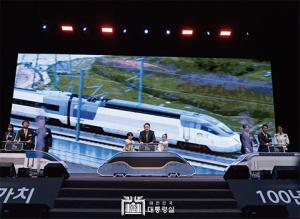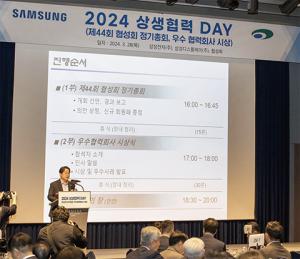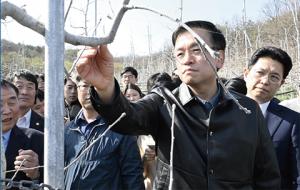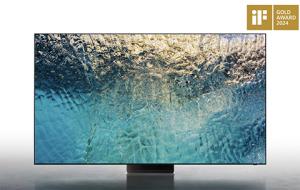 |
||
| ▲ 국전입선 작품 - 농촌마을 서정 (100호) | ||
"산(山)사랑하니 ‘신기(神氣)’어린 작품으로~”
‘사공명순 작가’가 펼쳐낸 아름다운 ‘산수화’ 호평
동양화 하면 먹과 선의 기법으로 여백의 미를 강조하는 화풍이 통설이다. 여기에 산수화는 여러 소재 중 가장 많이 쓰임으로써 전통적인 동양화의 본질을 이끌어 간다. 이처럼 동양 사상과 철학 등이 녹아있는 동양화는 서양화와는 다른 깊이와 매력이 있다. 단색으로 표현한 기암절벽은 출중하기 이를 데 없고, 운무가 흐르는 신비스런 절경은 황홀감에 매몰되어 시(詩)라도 한수 읊게 만드는 묘약이나 다름없다. 그리하여 가볍게 눈을 떼지 못하게 만드는데 요즘은 나아가서 다채색으로 어우러진 화폭에 보는 이들을 더욱 더 깊게 빠져들게 한다 <편집자 주>
풍부한 색감과 섬세하게 표현된 산수화
한국화 사공명순 작가는 중국의 ‘무이산(武夷山) 강변’을 비롯해 한국의 산세와 풍경 등 여러 가지의 심도 있는 작품을 내놓고 있다. 그의 작품에 등장하는 웅장한 자태의 산수화는 실경의 자연 그대로를 잘 살리면서 색감도 풍부한 것이 특징이다. 이는 전통 묵필법의 간결함과 달리 현대 실경 화풍의 사실적이고 담백한 멋과 채색의 표현인 전통방식에서 현대 수묵담채화로 발전되어진 것이다. 작품은 사실적인 자연에 깊이를 더해 기운과 생동감 넘치는 산과 바위, 계곡 등과 안개 낀 골짜기 능선이 주는 신비감 등을 세밀하게 묘사한 것으로 상당수를 이룬다.
이런 작품은 한국의 풍경에서도 마찬가지다. ‘고향일기’ 와 ‘강촌서정’(2005년), ‘십리화랑’(2006년), 추수(2007년), ‘여름계곡’ 과 ‘정선의 가을’(2010), ‘용경협소견’ 과 ‘비폭’(2012년), ‘유채밭’(2014년), ‘산길을 따라’ 와 ‘지리산 피아골’(2016년) 등의 작품에도 섬세한 색감이 나타나 있으며, 이외에도 ‘설경’ 등 우리네의 정겨운 풍경까지 매우 다양하다. 모두가 사공 작가가 화선지에 아름다운 색감과 섬세한 기법으로 펼쳐낸 작품들이다. 특히 최근의 작품으로 알알이 영글어 가는 ‘포도’ 그림은 서양화처럼 느껴지기도 한다. 하지만 이 작품도 기법만 조금 다를 뿐 마찬가지로 먹과 동양화 물감으로 완성된 것이다. 이런 점을 의식하고 있는 사공 작가는 “서양화에도 관심을 가져 동양화를 서양화에 접목 해보는 기법도 연구 중에 있다” 고 설명했다. 예를 들면 나무는 동양화 기법으로 먹의 선을 살리고 배경은 서양화 기법으로 색의 번짐, 포지티브와 네거티브 기법 등으로 깊이를 더해 주는 것이다.
문인화로 출발 기법 연구에 이르기까지 입지구축
‘산수화’는 중국인, ‘설경’은 일본인에게 호응 얻어
사공 작가는 문인화로 출발을 했다. 산수화로 전향한 건 1998년 쯤이다. 그 역시 여느 작가처럼 처음엔 단색의 작품을 산수화를 내 놓았으나 점차 발전되어 많은 작업을 하면서 붓과 손이 익숙해져 갔고, 지금은 집안의 대부분이 이런 작품으로 가득 차 있다. 작가로서 화력이 상당히 무르익었음을 가늠케 하는 대목이다. 그는 산수화를 하다가 간혹 문인화에 손을 대고 있을 만큼 이에 대한 미련을 버리지 못하고 있다. 작업은 대부분 자택에서 이뤄진다. 수많은 산수화를 비롯해 문인화, 화첩 등 다양한 작업에 심혈을 쏟아온 그에게 아파트의 조그만 작업 공간은 더없는 행복의 산실이기도 하다.
그렇다면 이토록 많은 작품을 할 수 있는 배경은 무엇일까. 여기엔 그만의 이유가 있다. 그의 남편은 직업 군인이였던 탓에 덩달아 수많은 이사를 하곤 했다. 이렇게 사공 작가는 남편을 따라 진해에서 인제, 원통, 화천까지 철책을 넘나드는 정신으로 무장해 전국 곳곳에 안다녀 본 곳이 없다. 그러다보니 가는 곳마다 자연스레 여행을 하게 되었고, 지금까지 이어져 국내 200대 명산에 도전에 거의 다 탔을 만큼 산을 사랑하는 사람이다. 중국도 황산, 장가계, 태산, 태항산, 백두산 등 명산을 전시 포함해 스무 차례나 다녀왔을 정도이다. 등산여행은 작품구상을 위함이기도 하고, 산이 좋아 매일 뒷산을 한 두 시간씩 오르고 매월 몇 개의 큰 산을 오른다고 한다. 이렇게 산사람이 되어 있는 사공 작가는 산 중에서도 겨울 산이 가장 매력적이라며 꼽는다. 앙상한 나뭇가지와 알몸으로 드러난 크고 작은 바위의 자태는 여름 산에 숨겨놓았던 보석을 보는 듯한 비경에 감탄하며 운 좋은 날엔 상고대와 함께 하얗게 핀 눈꽃을 보면 황홀감에 흠뻑 빠져든다고 한다. “산이 좋아 산에 가게 되고 걷다 보면 바위나 나무들이 다가와 주는 편안함과 안정감이 저의 작품에 활력소가 됩니다. 사람들이 그러더군요. 제 작품에는 ‘신끼’ 가 있다구요. 산과 내가 하나로 일치 될 때가 더욱 그런 것 같습니다” 이렇게 그가 산을 다니면서 보아둔 장면들은 빈틈없이 꼼꼼함으로 표현되어 생동감 넘치는 바위나 산의 기운 들이 화폭마다에 가득 채워져 갔다. 1년간 작업해 국전에 입선한 ‘농촌마을 서정’과 이듬해 국전 특선 작으로 뽑힌 지리산의 비경인 ‘피아골의 여름나기’ 또한 수많은 시간과 노력에서 얻어진 것이다. 하루에 작업 시간을 따로 정해 놓은 건 없지만 한번 빠지면 12시간을 불사하며 그림에 몰두하기도 했다. 그렇다고 늘 작업이 잘되는 건 아니었다 ‘작품이 잘 안 풀리고 재미없는 그림도 있어요. 그럴 때는 며칠씩 쳐다도 안 봅니다“ 며 솔직한 심정도 털어 놓았다.
아향회 회원 겸 고문활동, 개인전도 가질터.
열정과 도전 정신으로 변화를 추구하는 작가로.
사공 작가는 최근에 한국화 작가 단체인 ‘아향회’ 회장을 맡아 회원들을 이끌기도 했었다. ‘아향회’ 는 2002년에 발족해 그해 12월 7일 1회 작품전을 시작으로 2년에 한번 씩 정기적으로 인사동에서 전시회를 개최하고 있으며 30여 명의 회원들이 활동하는 모임이다. 현재 사공 작가는 ‘아향회’ 고문을 맡고 있다.
그는 작품 틈틈히 중국 작가들과 교류전에도 활발하게 참여했으며 중국 작가들은 한국화에 대한 관심도 많았을 뿐 아니라 이들과의 교류는 작품 발전에도 적지 않은 영향을 끼치곤 했다. 일본 요코하마현 교육위원장 상을 받은 사공 작가의 ‘설경’ 작품은 일본 사람들이 아주 좋아했다는 후문이다. 사공 작가의 작품은 10에서 100호로 다수를 이루지만 앞으로는 200호의 작품도 구상하고 있다. 이 작품이 완성되면 개인전을 가져본다는 계획이다. 또한 그는 작년에 했던 은평구의 ‘산새마을복지관’ 그림강사 경험을 살려 올 가을에 양주에 정착하면 복지회관에서 재능기부도 이어갈 생각이다. 산을 사랑하며 자연 그대로를 화폭에 하나하나 옮기며 열정을 쏟아가는 도전 정신. ‘송하(松下) 사공명순’ 작가의 작품 세계가 더욱 빛을 발하는 이유가 바로 여기에 있다.
<Art Power Interview / Korean painting artist Sa Gong Meong Soon>
“From love of mountains to the works of beyond human power”
Sa’s landscape paintings receive favorable reviews
Oriental painting is known to have emphasis on the beauty of ink, lines and emptiness. And among many themes, landscape painting is mostly used and leading the essence of traditional oriental painting. Embracing ideas and philosophies, oriental paintings have a great charm and depth different from western paintings. Monotone rock cliffs present outstanding values and mysterious clouds and mist lead us into ecstasy as if to recite a poem. Recently though, more added colors of landscape paintings are guiding the viewers to a closer contact with the works.
Abundant colors and delicateness of landscape paintings
Artist Sa Gong Meong Soon has released a number of landscape paintings including ‘Wǔyí Shān Riverside’ in China and the Korean landscapes executed in magnificence and abundant colors. Sa developed her style from modern realistic coloring and plain style of traditional methods to modern wash drawing. Many of her works gave details to lively rocks, mountains and valleys as well as mysterious ridges. Some of her famous works include ‘Home Town Diary’ and ‘Scenery of Riverside Village’ (2005), ‘Siprihwarang’ (2006), ‘Harvest’ (2007), ‘Summer Valleys’ and ‘Jeongseon in Autumn’ (2010), ‘Yonggyeonhyupsogyeon’ and ‘Bipok’ (2012), ‘Rape Flower Field’ (2014), ‘Along the Mountain Road’ and ‘Pia Valley of Jiri Mountain’ (2016) and ‘Snowy Scene’ sized from 53.0 x 40.9cm to 16.2 x 11.2cm on rice paper. Her recent work ‘Grapes’ might rather seem like a western painting but we can soon recognize it is an oriental painting applied with a slightly different method. Sa said “I grew my interest in western painting and is working on combining its elements with oriental painting.” For example, a tree is drawn in oriental style while the background uses western methods of color spread, positive and negative.
Securing her status from literati painting to study on technique
‘Landscape paintings’ receive fervent response in China
and ‘Snowy scenes’ in Japan
Sa started with literati painting at first and turned her course to landscape painting around 1998. She made her works in monotone but developed her dexterity through hard work to create most of the current works. While focusing on landscape painting, she kept a piece of her passion in the Four Gracious Plants. She works at home most of the time. The small studio in her apartment has been the source of her many works of landscape, literati and sketchbook paintings. She married to an army officer husband and had to live by a constant relocation of residence all over the nation from Inje County to Wontong to Hwacheon County. She used this itinerant environment for climbing 200 mountains. She also made 20 times of journey, including for exhibitions, to Mtn. Hwang, Zhangjiajie, Tae, Taehang and Paektu in China. Sa likes the winter mountain the most. The branches of trees and the rocks exposed to nature are like the jewels hidden during the summer and she gets enchanted by the snow flowers. “I like climbing mountains and the feeling that rocks and trees greet me with comfort. And I use the vitality for my work. People say that there is something beyond human power in my work and I think this is because I become one with mountain in my work” said Sa. Some of her mountain works include ‘Sentiment of Farm Village’, which was selected for Grand Exhibition of Korea and ‘Spectacular Jiri Mountain’ and ‘Spending Summer in Pia Valley’ which were selected for specials works for the same exhibition the next year. “Once I start a work, I spend 12 hours nonstop. But I don’t even take the brush for several days if I’m not in the right mood to create” said Sa.
Active as a member and advisor of Ahyangheo, holding solo exhibition
Sa pushes for change in passion and challenging spirit
Recently, Sa took the president position of Ahyangheo, an oriental painting artists organization. Ahyangheo was established in 2002 and held the first exhibition on 7 December 2002. It organizes a regular exhibition once every two years in Insa-dong and 30 members are currently engaged in activities. The members have a general meeting twice a year in June and December and a picnic is also organized in the spring and the summer. Currently, Sa is serving as an advisor of Ahyangheo. She held exchange exhibitions with Chinese artists from which she found some inspiration. Her work ‘Snowy Scene’ won the chairman’s prize of the education committee of Yokohama, Japan and it was loved my many Japanese according to a source. Though she mainly has created works with size from 53.0 x 40.9cm to 16.2 x 11.2cm, she is planning to make a 25.9cm x 18.1cm work in near future. When completed, she hopes to have an exhibition at Hyundai Asan Gallery. Meanwhile, Sa has provided painting lecture at Sansaemaeul Welfare Center in Eunpyeong District, Seoul since 2016 and will continue her talent donation to a welfare center in Yangju, the city which she soon move to. <Power Korea> sends a message of support.
홍기인 기자 forum1004@naver.com







